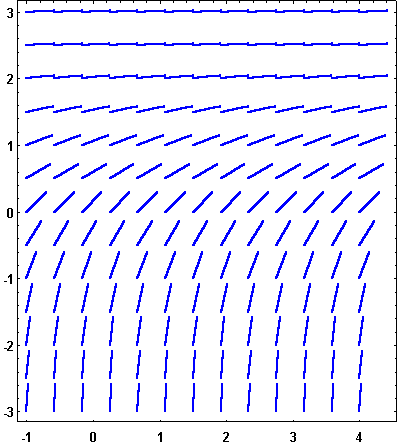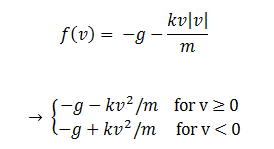Section 2.9 is entitled “Autonomous Equations and
Stability.”
So a first-order autonomous equation has the form x’
= f(x). This is a neat function because the independent variable doesn’t appear
explicitly on the right hand side of the equation. We’ve already seen an
example of an autonomous function, and that would be the differential equation
the air resistance proportional to the square of the velocity. That equation
was the following:
The independent variable t does not
appear anywhere on the right hand side of the equation, and thus this equation
is autonomous.
These types of equations actually happen
often in real world applications. Note: “A differential equation model of any
physical system that is evolving without external forces will almost always be
autonomous” (92).
Another cool thing about autonomous
equations is that the slopes of the direction lines in the direction field have
the same feature.
 |
| We see that the slopes don't change as you move from left to right. (sosmath.com) |
Qualitatively, we can find some really easy solutions pretty
quickly. For example, If f(x0) = 0, then x(t) = x0
satisfies x’(t) = 0 = f(x0) = f(x(t)).
Some definitions for you: the point x0 which
satisfies f(x0) = 0 is called an equilibrium point. This constant
function that arises because of the point x0, which is x(t) = x0
is called an equilibrium solution.
So, returning to our air resistance function, we look at the
right hand side of the equation and find that
Something important to point out is that f is a decreasing
function. This means it can only have one zero. F will be positive when v is
greater than zero, so this means that our zero (AKA our equilibrium point and
solution) must occur when v is less than zero. We have an equation for that, so
when we solve for v, we get that our equilibrium point and solution is
Tying back to what I attempted to
summarize/teach you in the last section (2.7, about uniqueness and existence
and all that noise), the function f and its derivative “-2k|v|/m” are both
continuous for v. This means the uniqueness theorem is satisfied and that’s
just fantastic. This also means equilibrium solutions (i.e. solution curves)
cannot touch. This means we have
When v(t) satisfies this, then f(v(t)) < 0. This means
that
This makes v(t) a monotonic decreasing
function (remember those fancy words from Calculus 1?). While we’re on the
subject of Calc 1, let’s look at the respective limits of this function. As t
goes to infinity, v approaches –sqrt(mg/k), and as t goes to negative infinity,
v approaches infinity.
So, for an initial value problem v(t0)
> -sqrt(mg/k) with the solution v(t), we can make three observations:
1. v(t) is monotone decreasing
2. v(t) goes to –sqrt(mg/k) as t goes to
infinity
3. v(t) goes to infinity as t goes to
negative infinity
Notice for our second observation, notice
that we got this answer back in section 2.3; we just called it terminal
velocity.
Moving on, our autonomous equation y’
= f(y) describes the motion along y(t). This makes sense since y’ is
a derivative and it involves slopes and motion and stuff. (Definition alert) a
phase line is the line along which y’ describes motion.
 |
| The horizontal line would be the phase line. |
Just a reminder, the point on the v line
is our equilibrium point, -sqrt(mg/k). Obviously, the left has our f(v)
increasing, so we indicate it with the blue arrow pointing to the right. The
right side of the equilibrium point is the opposite; it’s decreasing, and we
show that with the arrow pointing to the left.
If you have more than one equilibrium
point, you will have more than one phase line.
Let’s talk about stability now.
Sometimes, you have solution curves that
approach your equilibrium points as t becomes infinite. The special name for
these points is “asymptotically stable equilibrium points.” Sometimes, your
solution curves move away from your equilibrium points. These points are deemed
unstable equilibrium points. In terms of a graph, if your two arrows that you
draw on your graph point toward your point, then it’s an asymptotically stable
point.
So you might be saying at this point, “by
golly I want to deem points stable and unstable and other [these are called
semi-stable, but the book says not to stress about it]. I would like to know
how I can determine the stability of my equilibrium points.”
Well, by golly, I have a first derivative
test for stability for you!
“Suppose that x0 is an
equilibrium point for the differential equation x’ = f(x), where f
is a differentiable function.
1. If f’(x0) <
0, then f is decreasing at x0 and x0 is asymptotically
stable.
2. If f’(x0)
> 0, then f is increasing at x0 and x0 is unstable.
3. If f’(x0)
= 0, no conclusion can be drawn” (98).
Okay, now that we know everything there
is to know about autonomous equations (well, we can pretend we know
everything), we have a method to solve these pesky little things. I’m going to
use a direct quote on this too since, you know, summarizing a summary wouldn’t
work out so well.
“1. Graph the right-hand side f(x) and
add the phase line information on the x-axis. Find, mark, and classify the
equilibrium points where f(x) = 0. In each of the intervals limited by the
equilibrium points, find the sign of f and draw an arrow to the right is f is
positive and to left if f is negative.
2. Create a tx-plane, transfer the phase
line information to the x-axis, draw the equilibrium solutions, and then use
the phase line information to sketch non-equilibrium solutions in each interval
limited by the equilibrium points” (99).
That’s all for this section, I’m afraid.
You’ll hear from me when we move into the magical land of chapter 3. I’ll see
you when I see you! :D



No comments:
Post a Comment